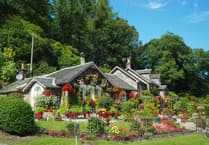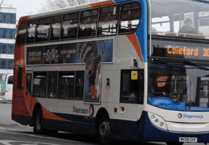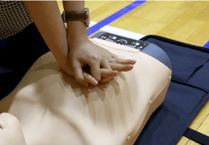Friends of the Lower Wye (FotLW) held a symposium entitled “Working Together – Saving the Wye” at Bridges last week.
Over 160 people attended, and were welcomed by Mike Dunsbee and Nick Day, founders of FotLW.
The meeting heard first from Bob Handley of Monmouth Rotary about some of the flooding threat from climate change and the work that Rotary have supported with the Wye and Usk Foundation.
Mike Dunsbee then outlined the key issues facing the River Wye, the activities that FotLW have carried out, and the achievements in the last two years. The latest figures show that pollution in the form of phosphate comes from rural land use (74%), sewage treatment works (21%), storm overflows (less than 1%), and septic tanks and urban run-off (5%). He highlighted the work that Welsh Water has brought forward, installing phosphate strippers in a number of water works, but more was needed. He said how important it was that governments, organisations and authorities must ‘Work Together’ to achieve a satisfactory outcome for the benefit of all, and was pleased that, for the first time, both the Environment Agency (EA) and Natural Resources Wales (NRW) were giving a joint presentation showing their progress and plans for the future.
Nick Day then gave a detailed view of the good work Citizen Scientists do by testing at various locations, and showed the general pattern across the whole of the Wye catchment before focussing on the Lower Wye area, and its tributaries. Looking in particular around Monmouth, Citizen Science testing shows significant worsening between the town and further down, just below Redbrook. In this stretch several sources flow into the Wye, with a ‘smoking gun’ pointing at the River Trothy as having particularly high levels of phosphate. He described two recent sets of samples spread across the Trothy sub-catchment where they had found a repeated pattern, with specific points having significantly high readings of phosphate. In the more recent data, in three cases, while a tributary’s source was tested and found to be very pure, extremely high levels (in one case 30 times the target) were measured only a short distance downstream.
NRW had been notified and were following through and liaising with FotLW. Nick also stated that due to the underfunding both authorities suffer from they should use the resources of Citizen Scientists more so they could then focus on the main locations of concern.
Mike & Nick had sent out the following questions to both authorities to present and answer. These were:
*What their body does and who they answer to?
*Plans going forward for short, medium and long term – 2023, 5 years and 10 years?
*Cross border working relationships now and in 5 years?
*How they view citizen science and their results?
There followed a very detailed presentation from both the EA and NRW which highlighted the work they carry out and how they work with farmers and landowners in identifying how to reduce the risk of causing pollution. Over 50 questions had been submitted and both authorities have undertaken to answer them.
Charles Watson, Chair of the national campaign group River Action, then gave an impassioned speech. Most of the water companies are owned by shareholders and investment funds abroad, and the financial framework has not encouraged investment in infrastructure. 25% of the UK’s chicken population is resident in the Wye catchment, and the majority of these are reared in operations tied to companies owned abroad. The chickens are sold to the major supermarket chains as ‘cheap’ but with no regard to the environmental costs. There is no provision for removal of the resultant surplus of manure, with the river effectively used as a giant waste disposal system. He pointed out
that, in relation to the two main causes of pollution (agriculture and sewage), the regulatory authorities are just not doing enough.
After a short break, Nicola Goodwin, BBC investigative reporter who acted as the Chair for the evening, asked questions of the two authorities. There were too many to answer but both authorities promised that written answers will be provided. These will be published in the FotLW newsletter; if you wish to subscribe to this, please email [email protected].
In the picture can be seen, left to right, Clare Dinnis (Area Director EA), Charles Watson (River Action), Martin Quine (EA), Emma Whithouse (EA), Nicola Goodwin (Chair), Jon Goldsworthy (NRW), then Holly Sisley (NRW), Mike Dunsbee (FotLW), Nick Day (FotLW).




